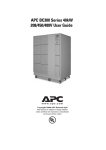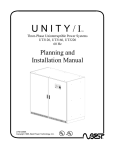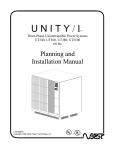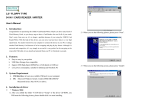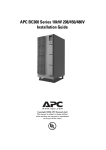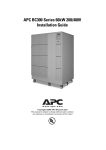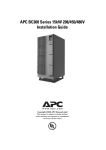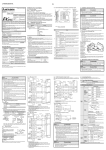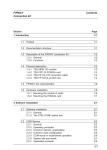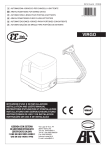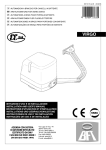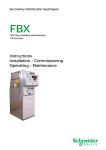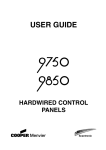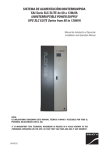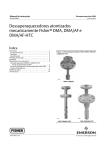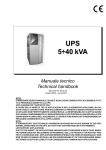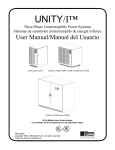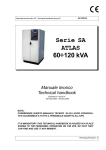Download Best Power Unity I Three Phase Installation Manual
Transcript
UNITY/I ™ Three-Phase Uninterruptible Power Systems UT310, UT315, UT320, UT330 60 Hz Planning and Installation Manual LTS-0371D Copyright 1995, Best Power Technology, Incorporated UT310, UT315, UT320, and UT330 Planning and Installation Manual IMPORTANT SAFETY INSTRUCTIONS SAVE THESE INSTRUCTIONS This manual contains important instructions for the UNITY/I™ three-phase UPS. The installation and use of this product must comply with all national, federal, state, municipal, or local codes that apply. If you need help, please call BEST’s Technical Support Center at 1-800-356-5737 (U.S.A. or Canada; elsewhere, call your local BEST office). WARNING! UPS units contain hazardous AC and DC voltages. A qualified electrician must install the UPS, AC line service, and external batteries according to local and national codes and must be familiar with batteries and battery installation. Before installing, maintaining, or servicing the UPS, shut off the UPS and disconnect all sources of AC and DC power. Whenever AC and/or DC voltage is applied, there may be AC voltage at the UPS output; this is true because the UPS can supply output power from mains or from its batteries. To avoid equipment damage or personal injury, always assume that there may be voltage at the UPS output. TEST BEFORE TOUCHING! To reduce the risk of fire or electric shock, install the UPS and external batteries in a temperature and humidity controlled indoor area, free of conductive contaminants. UPS batteries are high current sources. Shorting battery terminals or DC terminal strips can cause severe arcing, equipment damage and injury. A short circuit can cause a battery to explode. Always wear protective clothing and eye protection and use insulated tools when working near batteries. This unit contains components that are sensitive to electrostatic discharge (ESD). If you do not follow proper ESD procedures, you may cause severe damage to electronic components. UT310, UT315, UT320, and UT330 Planning and Installation Manual Table of Contents List of Tables and Figures . . . . . . . . . . . . . . . . . . . . . . . . . . . . . . . . . . . . . . . . . . . . . . . ii 100: Introduction . . . . . . . . . . . . . . . . . . . . . . . . . . . . . . . . . . . . . . . . . . . . . . . . . . . . . . . . . . . 1 101: UPS Footprints . . . . . . . . . . . . . . . . . . . . . . . . . . . . . . . . . . . . . . . . . . . . . . . . . . . . 2 102: Specifications for the UT310 and UT315 . . . . . . . . . . . . . . . . . . . . . . . . . . . . . . . . 4 103: Specifications for the UT320 and UT330 . . . . . . . . . . . . . . . . . . . . . . . . . . . . . . . . 6 104: Receiving and Moving the UPS . . . . . . . . . . . . . . . . . . . . . . . . . . . . . . . . . . . . . . . 9 105: Storing the UPS and Batteries . . . . . . . . . . . . . . . . . . . . . . . . . . . . . . . . . . . . . . . 10 106: Finding a Location for the UPS . . . . . . . . . . . . . . . . . . . . . . . . . . . . . . . . . . . . . . 10 107: Technical Support . . . . . . . . . . . . . . . . . . . . . . . . . . . . . . . . . . . . . . . . . . . . . . . . . 11 200: Installation . . . . . . . . . . . . . . . . . . . . . . . . . . . . . . . . . . . . . . . . . . . . . . . . . . . . . . . . . . . 11 201: Installing the Maintenance Bypass Cabinet (MBC) and UPS . . . . . . . . . . . . . . . 12 202: Installing the External Batteries and DC Disconnect (DCD) . . . . . . . . . . . . . . . . 21 300: Initial Startup and Phase Check . . . . . . . . . . . . . . . . . . . . . . . . . . . . . . . . . . . . . . . . . . 25 400: Clearing the Events Log . . . . . . . . . . . . . . . . . . . . . . . . . . . . . . . . . . . . . . . . . . . . . . . . 29 500: Shutdown Procedure . . . . . . . . . . . . . . . . . . . . . . . . . . . . . . . . . . . . . . . . . . . . . . . . . . . 30 600: Startup from Maintenance Bypass . . . . . . . . . . . . . . . . . . . . . . . . . . . . . . . . . . . . . . . . 31 700: Glossary of Terms and Abbreviations . . . . . . . . . . . . . . . . . . . . . . . . . . . . . . . . . . . . . . 32 701: Glossary of Terms . . . . . . . . . . . . . . . . . . . . . . . . . . . . . . . . . . . . . . . . . . . . . . . . . 32 702: Abbreviations . . . . . . . . . . . . . . . . . . . . . . . . . . . . . . . . . . . . . . . . . . . . . . . . . . . . 33 i UT310, UT315, UT320, and UT330 Planning and Installation Manual List of Tables and Figures Tables 1 2 3 4 5 6 7 8 9 10 UT310, UT315 AC Input Specifications . . . . . . . . . . . . . . . . . . . . . . . . . . . . . . . . . . . . 4 UT310, UT315 AC Output Specifications . . . . . . . . . . . . . . . . . . . . . . . . . . . . . . . . . . . 4 UT310, UT315 DC Input/Battery Specifications . . . . . . . . . . . . . . . . . . . . . . . . . . . . . . 5 UT310, UT315 General Specifications . . . . . . . . . . . . . . . . . . . . . . . . . . . . . . . . . . . . . . 5 UT310, UT315 Weight Specifications . . . . . . . . . . . . . . . . . . . . . . . . . . . . . . . . . . . . . . 6 UT320, UT330 AC Input Specifications . . . . . . . . . . . . . . . . . . . . . . . . . . . . . . . . . . . . 6 UT320, UT330 AC Output Specifications . . . . . . . . . . . . . . . . . . . . . . . . . . . . . . . . . . . 7 UT320, UT330 DC Input/Battery Specifications . . . . . . . . . . . . . . . . . . . . . . . . . . . . . . 7 UT320, UT330 General Specifications . . . . . . . . . . . . . . . . . . . . . . . . . . . . . . . . . . . . . . 8 UT320, UT330 Weight Specifications . . . . . . . . . . . . . . . . . . . . . . . . . . . . . . . . . . . . . . 8 Figures 1 2 3 4 5 6 7 8 9 10 11 12 13 UT310, UT315 Footprint with Conduit Connection Kit (Top View) . . . . . . . . . . . . . . . 2 UT320, UT330 Footprint with Conduit Connection Kit (Top View) . . . . . . . . . . . . . . . 3 UT310, UT315 Front View (Covers Removed) . . . . . . . . . . . . . . . . . . . . . . . . . . . . . . 13 UT310, UT315 Wiring Terminations . . . . . . . . . . . . . . . . . . . . . . . . . . . . . . . . . . . . . . 13 UT320, UT330 Front View (Covers Removed) . . . . . . . . . . . . . . . . . . . . . . . . . . . . . . 14 UT320, UT330 Wiring Terminations . . . . . . . . . . . . . . . . . . . . . . . . . . . . . . . . . . . . . . 14 UT310 - UT330 Installation Wiring Diagram, Typical Installation without External Maintenance Bypass Cabinet, with Internal Batteries . . . . . . . . 15 UT310 - UT330 Installation Wiring Diagram, Typical Installation with Internal Batteries and Maintenance Bypass Cabinet . . . . . . . . . . . . . . . . . . . 16 UT310 - UT330 Installation Wiring Diagram, Typical Installation with External Batteries and Maintenance Bypass Cabinet . . . . . . . . . . . . . . . . . . 17 External Connection Board . . . . . . . . . . . . . . . . . . . . . . . . . . . . . . . . . . . . . . . . . . . . . . 18 Communication Interface Board (Option) . . . . . . . . . . . . . . . . . . . . . . . . . . . . . . . . . . 19 Relay Board (Option) . . . . . . . . . . . . . . . . . . . . . . . . . . . . . . . . . . . . . . . . . . . . . . . . . . 20 DC Fuse Holder . . . . . . . . . . . . . . . . . . . . . . . . . . . . . . . . . . . . . . . . . . . . . . . . . . . . . . 26 ii UT310, UT315, UT320, and UT330 Planning and Installation Manual Section 100: Introduction An uninterruptible power system (UPS) protects sensitive equipment against unacceptable disturbances from the mains (AC line) supply. The UNITY/I™ three-phase UPS has the capacity to serve a wide variety of electrical equipment— from mainframe computers to enterprise-wide EDP installations to production lines. The UNITY/I three-phase UPS provides true on-line, single-conversion technology and harmonics isolation. Only a qualified electrician should install this unit. The planning and installation manual gives the electrician guidelines for: installation wiring. external battery installation. UPS startup procedures. phase check for the maintenance bypass cabinet. UPS shutdown procedures. If you need assistance, please have the UPS model number and serial number available and call BEST’s Technical Support Center at 1-800-356-5737 (U.S.A. or Canada) or call your local BEST office. 1 UT310, UT315, UT320, and UT330 Planning and Installation Manual 101 UPS Footprints See Figure 1 for a footprint of UPS model UT310 or UT315. See Figure 2 for a footprint of UPS model UT320 or UT330. Figure 1: UT310, UT315 Footprint with Conduit Connection Kit (Top View) Inches Millimeter s A 23.6 600 B 20.1 510 C 2.4 60 D 19.8 504 E 27.9 708 F 31.7 804 For service clearance and air flow, allow a minimum of 3 feet (914 mm) at the front, 3 feet (914 mm) at the top, and 6 inches (152 mm) at the back. CONDUIT CONNECTION BOX Cable entry from bottom only. Conduit connection kit includes one conduit connection box and two pedestals, shipped separately. 2 UT310, UT315, UT320, and UT330 Planning and Installation Manual Figure 2: UT320, UT330 Footprint with Conduit Connection Kit (Top View) CONDUIT CONNECTION BOX CABLE ENTRY Inches Millimeters A 39.4 1000 B 21.3 540 C 14.6 370 D 19.8 504 E 27.9 708 F 31.7 804 G 2.4 60 For service clearance and air flow, allow a minimum of 3 feet (914 mm) at the front, 3 feet (914 mm) at the top, and 6 inches (152 mm) at the back. Cable entry from bottom only. Conduit connection kit includes one conduit connection box and three pedestals, shipped separately. 3 UT310, UT315, UT320, and UT330 Planning and Installation Manual 102 Specifications for the UT310 and UT315 Tables 1 - 5 contain specifications for UPS models UT310 and UT315. Table 1: UT310, UT315 AC Input Specifications UT310 Voltage Rated input current - Amps UT315 3 x 208Y/120 37 3 x 480Y/277 16 3 x 208Y/120 55 3 x 480Y/277 24 Recommended overcurrent protection - Amps 1 50 20 70 30 UL rating of terminal blocks - AWG 2, 3 10 - 0 14 - 4 10 - 0 14 - 4 Mains tolerance - % (programmable) Bypass tolerance - % (programmable) Frequency - Hz Current distortion - % THD +10, -15 ±10 60 ±6% 0-5 +10, -15 ±10 60 ±6% 0-5 +10, -15 ±10 60 ±6% 0-5 +10, -15 ±10 60 ±6% 0-5 Table 2: UT310, UT315 AC Output Specifications UT310 Voltage Rated output current - Amps Recommended overcurrent protection - Amps UL rating of terminal blocks - AWG 2, 3 UT315 3 x 208Y/120 28 35 480Y/277 12 15 3 x 208Y/120 42 60 480Y/277 18 25 10 - 0 14 - 4 10 - 0 14 - 4 Tolerance - % - symmetrical load - asymmetrical load 4 - load step 0-100% ±1 ±3 ±5 ±1 ±3 ±5 ±1 ±3 ±5 ±1 ±3 ±5 Distortion (linear load) - % Frequency - Hz - mains synchronized - free running Overload capacity - % - mains operation, 1 minute - mains operation, 10 minutes - battery operation, 1 minute - battery operation, 10 minutes 0-3 0-3 0-3 0-3 60 ±6% 60 ±0.1% 60 ±6% 60 ±0.1% 60 ±6% 60 ±0.1% 60 ±6% 60 ±0.1% 250 150 150 125 250 150 150 125 250 150 150 125 250 150 150 125 Notes for Tables 1 and 2: 1 For UPS module only (UPS input breaker). For units with external bypass, see Figures 8 and 9. 2 Conductor size may vary based on installation requirements. Size all conductors per applicable codes. 3 For a 100% non-linear load, recommended practice is to size the neutral conductor for 1.732 times the phase current. 4 100% imbalance, provided output current rating is not exceeded. 4 UT310, UT315, UT320, and UT330 Planning and Installation Manual Table 3: UT310, UT315 DC Input/Battery Specifications Nominal DC current - Amps UL rating of terminal blocks - AWG 1 Nominal DC voltage Nominal number of cells Factory-set float charge voltage 2 Charger current limit - Amps 3 Inverter efficiency - % - 100% load - 75% load - 50% load - 25% load UT310 UT315 50 75 14 - 00 14 - 00 216 216 108 108 246 246 6 8 89 89 87 84 90 90 88 85 Notes for Table 3: 1 Terminal block has two positive and two negative 8 mm (.5/16") studs, hardware provided. Lug required. Conductor size may vary based on installation requirements. Size all conductors per applicable codes. 2 Adjust the float charge voltage setting per the battery manufacturer’s recommendations. 3 Programmable to lower level. Table 4: UT310, UT315 General Specifications Noise attenuation - dB - differential mode - common mode Typical heat dissipation - kW (BTU) - full rated load, normal operation - full rated load, economy mode - 0.8 PF load, normal operation - 0.8 PF load, economy mode Efficiency, AC to AC - % - normal operation - economy mode Air flow - CFM (m3/hour) Humidity, non-condensing maximum - % Ambient UPS and battery temperature - oF (o C) Ideal UPS and battery temperature - o F (o C) Audible noise, typical - dBa UPS dimensions, with conduit connection kit H x W x D - inches (mm) 5 UT310 UT315 60 120 60 120 0.75 (2569) 0.53 (1796) 0.60 (2055) 0.42 (1437) 1.13 (3853) 0.79 (2694) 0.90 (3083) 0.63 (2156) 93 95 93 95 294.5 (500) 294.5 (500) 95 95 32 - 104 (0 - 40) 32 - 104 (0 - 40) 77 (25) 77 (25) 55 55 59.1 x 23.5 x 31.5 (1500 x 600 x 800) 59.1 x 23.5 x 31.5 (1500 x 600 x 800) UT310, UT315, UT320, and UT330 Planning and Installation Manual Table 5: UT310, UT315 Weight Specifications UT310 UT315 UPS weight without batteries, with conduit connection kit - lbs (kg) 749 (340) 901 (409) Floor loading - UPS without batteries, with conduit connection kit - lbs/in2 (kPa) 5.69 (39.22) 6.84 (47.18) 16 30 9 16 UPS weight with internal batteries and conduit connection kit - lbs (kg) 1111 (504) 1331 (604) 1237 (561) 1464 (664) Floor loading - UPS with internal batteries and conduit connection kit - lbs/in2 (kPa) 8.44 (58.17) 10.11 (69.69) 9.39 (64.77) 11.12 (76.65) Internal battery runtime (at 0.8 PF) - minutes 1 Notes for Table 5: 1 For units with internal batteries, unit weights and runtimes vary depending upon the battery pack ordered. Runtimes are based on standard internal battery packs. 103 Specifications for the UT320 and UT330 Tables 6 - 10 contain specifications for UPS models UT320 and UT330. Table 6: UT320, UT330 AC Input Specifications UT320 Voltage UT330 3 x 208Y/120 3 x 480Y/277 3 x 208Y/120 3 x 480Y/277 Rated input current - Amps 73 32 111 48 Recommended overcurrent protection - Amps 1 100 40 150 60 UL rating of terminal blocks - AWG2, 3 10 - 0 10 - 0 10 - 0 10 - 0 Mains tolerance - % (programmable) +10, -15 +10, -15 +10, -15 +10, -15 Bypass tolerance - % (programmable) ±10 ±10 ±10 ±10 60 ±6% 60 ±6% 60 ±6% 60 ±6% 0-5 0-5 0-5 0-5 Frequency - Hz Current distortion - % THD Notes for Table 6: 1 For UPS module only (UPS input breaker). For units with external bypass, see Figures 8 and 9. 2 Conductor size may vary based on installation requirements. Size all conductors per applicable codes. 3 For a 100% non-linear load, recommended practice is to size the neutral conductor for 1.732 times the phase current. 6 UT310, UT315, UT320, and UT330 Planning and Installation Manual Table 7: UT320, UT330 AC Output Specifications UT320 Voltage UT330 3 x 208Y/120 3 x 480Y/277 3 x 208Y/120 3 x 480Y/277 Rated output current - Amps 56 24 83 36 Recommended overcurrent protection - Amps 70 30 125 45 L1, L2, L3: 10 0 Neutral: 4 - 00 L1, L2, L3: 14 4 Neutral: 4 - 00 L1, L2, L3: 10 0 Neutral: 4 - 00 L1, L2, L3: 14 4 Neutral: 4 - 00 Tolerance - % - symmetrical load - asymmetrical load 3 - load step 0-100% ±1 ±3 ±5 ±1 ±3 ±5 ±1 ±3 ±5 ±1 ±3 ±5 Distortion (linear load) - % 0-3 0-3 0-3 0-3 Frequency - Hz - mains synchronized - free running 60 ±6% 60 ±0.1% 60 ±6% 60 ±0.1% 60 ±6% 60 ±0.1% 60 ±6% 60 ±0.1% 250 150 150 125 250 150 150 125 250 150 150 125 250 150 150 125 UL rating of terminal blocks AWG 1, 2 Overload capacity - % - mains operation, 1 minute - mains operation, 10 min. - battery operation, 1 minute - battery operation, 10 min. Notes for Table 7: 1 Conductor size may vary based on installation requirements. Size all conductors per applicable codes. 2 For a 100% non-linear load, recommended practice is to size the neutral conductor for 1.732 times the phase current. 3 100% imbalance, provided output current rating is not exceeded. Table 8: UT320, UT330 DC Input/Battery Specifications UT320 UT330 100 150 14 - 00 14 - 00 Nominal voltage 216 216 Nominal number of cells 108 108 246 246 10 15 90 90 88 85 91 91 89 86 Nominal DC current - Amps UL rating of terminal blocks AWG 1 Factory-set float charge voltage 2 Charger current limit - Amps Inverter efficiency - % 3 - 100% load - 75% load - 50% load - 25% load Notes for Table 8: 1 Terminal block has two positive and two negative 8 mm (.5/16") studs, hardware provided. Lug required. Conductor size may vary based on installation requirements. Size conductors per applicable codes. 2 Adjust the float charge voltage setting per the battery manufacturer’s recommendations. 3 Programmable to lower level. 7 UT310, UT315, UT320, and UT330 Planning and Installation Manual Table 9: UT320, UT330 General Specifications UT320 UT330 60 120 60 120 Typical heat dissipation - kW (BTU) - full rated load, normal operation - full rated load, economy mode - 0.8 PF load, normal operation - 0.8 PF load, economy mode 1.28 (4357) 0.83 (2844) 1.02 (3486) 0.67 (2275) 1.91 (6536) 1.25 (4266) 1.53 (5228) 1.00 (3413) Efficiency, AC to AC - % - normal operation - economy mode 94 96 94 96 294.5 (500) 294.5 (500) 95 95 32 - 104 (0 - 40) 32 - 104 (0 - 40) 77 (25) 77 (25) 55 55 59.1 x 39.4 x 31.5 (1500 x 1000 x 800) 59.1 x 39.4 x 31.5 (1500 x 1000 x 800) Noise attenuation - dB - differential mode - common mode Air flow - CFM (m3/hour) Humidity, non-condensing maximum - % Ambient UPS and battery temperature - o F (o C) Ideal UPS and battery temperature - o F (o C) Audible noise, typical - dBa UPS dimensions, with conduit connection kit H x W x D - inches (mm) Table 10: UT320, UT330 Weight Specifications UT320 UT330 UPS weight without batteries, with conduit connection kit - lbs (kg) 1176 (533) 1330 (603) Floor loading - UPS without batteries, with conduit connection kit - lbs/sq. in (kPa) 5.95 (41.05) 6.73 (46.42) Internal battery runtime (at 0.8 PF) - minutes 1 12 16 30 9 16 UPS weight with internal batteries and conduit connection kit - lbs (kg) 1748 (793) 1882 (854) 2317 (1051) 2112 (958) 2438 (1106) 8.85 (61.02) 9.53 (65.69) 11.73 (80.88) 10.69 (73.72) 12.34 (85.10) Floor loading - UPS with conduit connection kit and internal batteries - lbs/in.2 (kPa) Notes for Table 10: 1 For units with internal batteries, unit weights and runtimes vary depending upon the battery pack ordered. Runtimes are based on standard internal battery packs. 8 UT310, UT315, UT320, and UT330 Planning and Installation Manual 104 Receiving and Moving the UPS WARNING! The UPS and related equipment are very heavy. To prevent personal injury or equipment damage, use extreme care when handling and transporting the UPS cabinet and related equipment. 1. While the UPS system is still on the truck, inspect the equipment and shipping container(s) for any signs of damage. Do not install the system if damage is apparent. If damage has occurred, notify BEST as soon as possible. 2. Compare the shipment with the bill of lading. Report any missing items to the carrier and to BEST immediately. 3. Remove the screws on the bottom part of the packaging side plates. 4. Lift the main package up and off the unit and remove the packing materials from the unit. 5. Check that the label inside the front door corresponds to the system ordered, especially the input/output voltages. 6. Unbolt the unit from the pallet. 7. Remove the unit from the pallet with a fork lift. 8. Use a fork lift or hand truck to transport the unit to the installation site or storage site. Study the footprint to decide how you will move the UPS through doorways and into position. 9. Install the separately shipped conduit connection kit. See the conduit connection kit for installation instructions. 9 UT310, UT315, UT320, and UT330 Planning and Installation Manual 105 Storing the UPS and Batteries You can store the UNITY/I UPS between -4 o and 104 o F (-20 o and 40 o C). However, BEST recommends that the unit and batteries be stored between 59 o and 77 o F (15 o and 25 o C). This temperature range, or cooler, allows batteries to have a longer shelf life. Recharge stored batteries every 90 to 120 days. 106 Finding a Location for the UPS Keep these guidelines in mind when you choose the location for the UPS system and the batteries. Place the UPS in a clean, dust-free air, free of contaminants. The air must be free to circulate around the UPS cabinet and any battery cabinets or racks. Avoid placing the unit in direct sunlight or near other heat sources. Make sure that the ambient temperature is 32 o to 104 o F (0 o to 40 o C). Ideal temperature is 77 o F (25 o C). NOTE: At 95 o F (35 o C), battery life will be about one-half what it would be at a normal temperature of 77 o F (25 o C). At 113 o F (45 o C), battery life will be about onefourth normal. Make sure that the floor can support the weight of the UPS, external batteries, and any other necessary equipment. See Tables 5 and 10 for floor loading specifications. The unit can be placed close to walls as long as there is enough clearance for the front door(s) to open. Required service clearance is 3 feet (914 mm) at the front and 3 feet (914 mm) at the top of the unit. If possible, allow 3 feet (914 mm) of clearance around the entire unit for easier installation and servicing. All service access is from the front and top of the unit. All cable entry is from the bottom of the unit. Do not operate the UPS or batteries in a sealed room or container. 10 UT310, UT315, UT320, and UT330 Planning and Installation Manual 107 Technical Support Best Power Technology, Incorporated is committed to outstanding customer service. Our Technical Support Center is happy to help you with any problems or answer any questions you may have. A service technician is available 24 hours a day, 365 days a year. Please have the UPS model number and serial number available when you call. The numbers are on the ID label located inside the front door. Technical Support: 1-800-356-5737 (U.S.A. and Canada) or 1-608-565-2100 Technical Support Fax: 1-608-565-7642 or 1-608-565-2509 Bulletin Board Service: 1-608-565-7424 CompuServ: Type “Go BEST” at any ! prompt Section 200: Installation WARNING! Before continuing, read the warnings on the inside front cover of this manual. The installation instructions in this section are for a UPS with a BEST maintenance bypass cabinet (MBC). Insulated Tools and Other Equipment Needed: Torque wrench in inch-pounds or newton-meters Standard U.S. and metric wrenches Petroleum jelly or conductive grease Mallet Volt-Ohm meter (True RMS - Digital) Pliers Ratchet and sockets Electrical tape Standard and Phillips screwdrivers Torx head screwdriver set Brush (for applying petroleum jelly or conductive grease to battery terminals) UNITY/I User Manual Phase rotation meter The customer must provide all cabling and interconnection hardware. 11 UT310, UT315, UT320, and UT330 Planning and Installation Manual 201 Installing the Maintenance Bypass Cabinet (MBC) and UPS IMPORTANT! If you do not have a BEST maintenance bypass cabinet (MBC), you must provide overcurrent protection and a UPS input AC disconnect means. BEST strongly recommends that a means of bypassing the UPS from the critical load be provided for maintenance. Follow these guidelines when installing the MBC and UPS: Use the information in Section 106 to find an appropriate location for the UPS. Install the conduit connection kit per the instructions provided with the conduit connection kit. Install the MBC within sight of the UPS. When installing the MBC, see Figure 8 or 9 and any instructions provided with the MBC. Install all wiring in accordance with applicable electrical codes. Use 75C copper conductors. Install the AC input and UPS output in separate conduits. UPS output circuits shall be installed in dedicated conduit systems and not shared with other electrical circuits. Control wiring must be installed in separate conduit. Good ground connections are necessary to reduce electrical noise and make the operation of the UPS and the loads safe. Follow the grounding guidelines in the installation wiring diagram. Refer to the National Electrical Code (NEC), appropriate IEEE documents, and all applicable codes. For systems with non-linear loads, standard practice is to size the neutral conductor for 1.732 times the phase current. When installing the AC wiring, refer to Figure 7, 8, or 9 and to any additional diagrams provided with the UPS. Figures 7, 8, and 9 show typical installations. Your installation may differ. See Figure 3 or 5 for a view of the UPS with covers removed. See Figure 4 or 6 for UPS wiring terminations. See Figure 10 for information on the external connection board. See Figure 11 for information on the optional communication interface board. See Figure 12 for information on the optional relay board. If you have any questions, contact BEST’s Technical Support Center for assistance. 12 UT310, UT315, UT320, and UT330 Planning and Installation Manual Figure 3: UT310, UT315 Front View (Covers Removed) Figure 4: UT310, UT315 Wiring Terminations 13 UT310, UT315, UT320, and UT330 Planning and Installation Manual Figure 5: UT320, UT330 Front View (Covers Removed) Figure 6: UT320, UT330 Wiring Terminations 14 UT310, UT315, UT320, and UT330 Planning and Installation Manual Figure 7: UT310 - UT330 Installation Wiring Diagram, Typical Installation without External Maintenance Bypass Cabinet, with Internal Batteries ADDITIONAL NOTES: A qualified electrician must install the UPS according to all applicable codes. All power and control wires must be in separate conduits. The grounding electrode conductor (protective earth—PE) must be the same size (ampacity) as the UPS input circuit conductors. Conduit is not an acceptable grounding electrode conductor—see National Electrical Code Section 250-91(a). The unit is wired from the factory as a separately derived system. Output neutral is bonded to equipment ground through main bonding jumper inside the UPS. See National Electrical Code Article 250-5(d) and 25026 for proper installation grounding. NOTE 1: (a) For a UT310 or UT315, see Table 1 in Section 102 for recommended UPS input overcurrent protection. (b) For a UT320 or UT330, see Table 6 in Section 103 for recommended UPS input overcurrent protection. NOTE 2: (a) For a UT310 or UT315, see Table 2 in Section 102 for recommended UPS output overcurrent protection. (b) For a UT320 or UT330, see Table 7 in Section 103 for recommended UPS output overcurrent protection. NOTE 3: You must provide overcurrent protection and UPS input AC disconnect means. 15 UT310, UT315, UT320, and UT330 Planning and Installation Manual Figure 8: UT310 - UT330 Installation Wiring Diagram, Typical Installation with Internal Batteries and Maintenance Bypass Cabinet ADDITIONAL NOTES: A qualified electrician must install the UPS according to all applicable codes. Power and control wires must be in separate conduits. The grounding electrode conductor (protective earth—PE) must be the same size (ampacity) as the UPS input circuit conductors. Conduit is not an acceptable grounding electrode conductor—see National Electrical Code Section 250-91(a). The unit is wired from the factory as a separately derived system. Output neutral is bonded to equipment ground through main bonding jumper inside the UPS. See National Electrical Code Article 250-5(d) and 25026 for proper installation grounding. If you do not have a BEST-supplied maintenance bypass cabinet (MBC), you must provide a UPS input AC disconnect means. You must also provide UPS input and output overcurrent protection. The maintenance bypass switch must be a 4-pole device which switches all three phases and neutral. If you are using a 3-pole device, contact BEST’s Technical Support Center for instructions to convert the unit to a not-separately derived system. NOTE 1: Size the mains input overcurrent protection device per applicable codes. See the table below for mains input voltage and current ratings. Mains Input UPS Model UT310 UT315 UT320 UT330 VAC Maximum Amps 208 50 480 22 208 76 480 32 208 100 480 43 208 149 480 65 16 UT310, UT315, UT320, and UT330 Planning and Installation Manual Figure 9: UT310 - UT330 Installation Wiring Diagram, Typical Installation with External Batteries and Maintenance Bypass Cabinet NOTE 1: Size the mains input overcurrent protection device per applicable codes. See the table below for mains input voltage and current ratings. Mains Input UPS Model UT310 UT315 UT320 UT330 VAC Maximum Amps 208 50 480 22 208 76 480 32 208 100 480 43 208 149 480 65 ADDITIONAL NOTES: A qualified electrician must install the UPS according to all applicable codes. Power and control wires must be in separate conduits. The grounding electrode conductor (protective earth—PE) must be the same size (ampacity) as the UPS input circuit conductors. Conduit is not an acceptable grounding electrode conductor—see National Electrical Code Section 250-91(a). The unit is wired from the factory as a separately derived system. Output neutral is bonded to equipment ground through main bonding jumper inside the UPS. See National Electrical Code Article 250-5(d) and 25026 for proper installation grounding. If you do not have a BEST-supplied maintenance bypass cabinet (MBC), you must provide a UPS input AC disconnect means. You must also provide UPS input and output overcurrent protection. The maintenance bypass switch must be a 4-pole device which switches all three phases and neutral. If you are using a 3-pole device, contact BEST’s Technical Support Center for instructions to convert the unit to a not-separately derived system. NOTE 2: (a) Refer to any instructions provided with the DC disconnect (DCD) and pre-charge/discharge box. (b) The pre-charge/discharge box must be located less than 10 feet (3048 mm) from the DC disconnect. 17 UT310, UT315, UT320, and UT330 Planning and Installation Manual Figure 10: External Connection Board Use Class 1 wiring methods. 1 NOT USED X001 NOT USED X002 NOT USED X005 NOT USED 3 1 NOT USED X006 3 1 SUMMARY ALARM IF 1-3 CONNECTED 2 X007 3 1 BATTERY OPERATION (30 SECS. DELAY) 1 - 3 CONNECTED IF IN BATTERY OPERATION 2 X008 3 1 EXTERNAL BYPASS CONTACT 1-3 CONNECTED IF SYSTEM IS IN STATIC BYPASS OPERATION 2 X009 3 1 2 NOT USED X010 3 1 MBC INHIBIT; IF SYSTEM OUTPUT IS OUTSIDE LIMITS THEN 1-3 ARE CONECTED 2 1 2 NOT USED POSITION INDICATOR OF DCD IN OPTIONAL BATT. CABINET A JUMPER MUST BE USED IF THE UNIT HAS INTERNAL BATTERIES BATTERY TEMPERATURE COMPENSATION PROBE X011 3 3 110 BROWN BLUE 4 X003 5 TO CONTROLLER BOARD 6 7 POSITION INDICATOR OF EXTERNAL UPS BYPASS SWITCH 8 9 10 NOT USED X012 11 REMOTE START/STOP 13 COMMON, 11 "ON", 12 "OFF" (CLOSING CONTACTS) 12 13 EMERGENCY SHUT DOWN IF 12VDC (10mA) EXTERNAL SUPPLY IS REMOVED FROM TERMINALS. TO USE THIS FUNCTION REMOVE JUMPER SWO1 SW01 14 15 16 EMERGENCY SHUT DOWN IF DISCONNECTED (12V CIRCUIT) 111 X004 17 X007-X011 ARE CHANGE OVER RELAY CONTACTS (NOT TO EXCEED NEC ART. 725 C CLASS 2 LIMITS) 18 NOT USED UT310, UT315, UT320, and UT330 Planning and Installation Manual Figure 11: Communication Interface Board (Option) Use Class 1 wiring methods. Not Used To Controller X002 X001 X003 25 PIN SUB D MALE X004 25 PIN SUB D MALE X005 25 PIN SUB D FEMALE COMMUNICATION INTERFACE BOARD X005 X004 X003 Serial Port RS232 Serial Port 0 - 20 mA current loop RELAY CONTACTS: 30 VAC, 60 VDC Maximum 0.5 A, Minimum 0.05 mA COM-PORT 14 15 2 “UPS on” (shown with UPS off) 16 17 4 “Static bypass operation” (shown with static bypass operation off) 18 19 6 “Battery operation” (shown with battery operation off) 20 21 8 “Battery low warning” (shown with “battery low” warning off) 13 + 25 – Remote UPS shut down input (3.5 - 25 VDC pulse for 1 second minimum) 19 UT310, UT315, UT320, and UT330 Planning and Installation Manual Figure 12: Relay Board (Option) Not available on the UT310 and UT315. The relays are shown in the alarm position and correspond to non-energized coils. RELAY BOARD X002:1 2 3 MAINS FAILURE X003:1 2 3 BATTERY CHARGING FAILURE X004:1 2 3 Description Minimum Maximum Contact voltage - AC 6V 250 V Contact current - AC * 50 mA 8A 6 V / 50 mA 250 V / 0.3 A 6V/8A Contact voltage and current - DC * * Resistive load OVERLOAD X005:1 2 3 FAN FAILURE X006:1 2 3 INVERTER FUSE FAILURE X007:1 2 3 LOW BATT. VOLTAGE X008:1 2 3 HIGH TEMPERATURE X009:1 2 3 BATTERY DCD OFF X010:1 2 3 OUTPUT VOLTAGE OUTSIDE LIMITS X011:1 2 3 UPS ON STATIC BYPASS X012:1 2 3 EXTERNAL MANUAL BYPASS ON X013:1 2 3 NORMAL OPERATION X014:1 2 3 COMMON FAULT X015:1 2 3 BYPASS VOLTAGE OUTSIDE LIMITS X016:1 2 3 BATTERY OPERATION X017:1 2 3 NOT USED 20 UT310, UT315, UT320, and UT330 Planning and Installation Manual 202 Installing the External Batteries and DC Disconnect (DCD) Some units have optional external batteries in a separate cabinet or rack. External batteries must be installed and connected to the UPS by a qualified service person who is familiar with UPS battery installations and applicable building and electrical codes. The qualified service person should read this entire section before the UPS and batteries arrive. DANGER! Full voltage and current are always present at the battery terminals. The batteries used in this system can produce dangerous voltages, extremely high currents, and a risk of electric shock. They may cause severe injury if the terminals are shorted together or to ground (earth). You must be extremely careful to avoid electric shock and burns caused by contacting battery terminals or shorting terminals during battery installation. Do not touch uninsulated battery terminals. A qualified service person who is familiar with battery systems and required precautions must install and service the batteries. The installation must conform to national and local codes. Keep unauthorized personnel away from batteries. The qualified service person must take these precautions: 1. Wear protective clothing, such as rubber gloves and boots and protective eye wear. Batteries contain caustic acids and toxic materials and can rupture or leak if mistreated. Remove rings and metal wristwatches or other metal objects and jewelry. Do not carry metal objects in your pockets where the objects can fall into the battery cabinet. 2. Tools must have insulated handles and must be insulated so that they will not short battery terminals. Do not allow a tool to short between individual or separate battery terminals or to the cabinet or rack. Do not lay tools or metal parts on top of the batteries, and do not lay them where they could fall onto the batteries or into the cabinet. 3. Install the batteries as shown on the drawing provided with the batteries. When connecting cables, never allow a cable to short across a battery’s terminals, the string of batteries, or to the cabinet or rack. 4. Align the cables on the battery terminals so that the cable lug will not contact any part of the cabinet or rack, even if the battery is moved. Keep the cable away from any sharp metal edges. 5. Install the battery cables so they cannot be pinched by the UPS or battery cabinet doors. 21 UT310, UT315, UT320, and UT330 Planning and Installation Manual DANGER! 6. Do not connect the battery terminal to ground (earth). If any battery terminal is inadvertently grounded, remove the source of the ground. Contacting any part of a grounded battery can cause a risk of electric shock. 7. To reduce the risk of fire or electric shock, install the batteries in a temperature and humidity controlled indoor area, free of contaminants. 8. Battery system chassis ground (earth) must be connected to the UPS chassis ground (earth). If you use conduit, this ground conductor must be routed in the same conduit as the battery conductors. 9. Where conductors may be exposed to physical damage, protect the conductors in accordance with all applicable codes. 10. If you are replacing batteries or repairing battery connections, shut off the UPS and remove both AC and DC power. Follow these guidelines when installing the batteries: Refer to any instructions provided with the batteries. Refer to any instructions provided with the DC disconnect (DCD) and pre-charge/discharge switch. External batteries require a fused disconnect or a DC circuit breaker. There should be a disconnecting means for each battery string. The external battery fuse protects the battery cables. Size the cables based on the overcurrent protection device. The battery cables must be sized for a total maximum voltage drop of 2.0 VDC at the rated DC current. Wherever conductors may be exposed to physical damage, protect the conductors in accordance with any applicable codes. This includes battery cables between the UPS and the battery system and cables between battery cabinets or racks. BEST recommends routing battery cables through flexible conduit. Install flexible conduit for battery cables according to local or national code. The battery system ground (earth) must be connected to the UPS chassis ground (earth). This ground conductor must be routed with the battery cables. 22 UT310, UT315, UT320, and UT330 Planning and Installation Manual Clean the cables and battery terminals before making the battery connections. Apply a thin coating of conductive grease before making the battery connections, or apply petroleum jelly to the entire connection after it has been made. Torque battery connections to the battery manufacturer’s specifications. Follow the steps below and any instructions provided with the battery system: 1. Verify that the DC fuses are removed from the UPS. See Figure 3 or 5 for the location of the DC fuse holder. 2. Install the ground conductor. See Figure 4 or 5 for the location of the grounding electrode terminals in the UPS. 3. Connect the cables between batteries. 4. a. In each battery string, connect the cables between batteries as shown in the battery installation diagram provided with the batteries. b. Meter the positive (+) and negative (–) terminal on each battery string to verify proper nominal voltage and polarity. Connect the battery cables between battery strings. a. Connect the negative () cables between battery strings as shown in the battery installation diagram provided with the batteries. b. Meter the DC voltage between the positive terminals of the strings. The voltage should measure less than 5 volts. If it measures greater than 5 volts, correct any wiring errors before you continue. c. Connect the positive (+) cables between battery strings as shown in the battery installation diagram provided with the batteries. 5. Install the DC disconnect (DCD) and pre-charge/discharge switch. Refer to Figure 7, 8, or 9 and to any instructions provided with the DCD and pre-charge/discharge switch. 6. Connect the external batteries to the UPS. a. Connect the positive (+) cable(s) to the UPS first. Install ring connectors for 8 mm (5/16") bolts as required. b. To prevent short circuits, insulate the UPS end of the negative (–) cable(s). Do not connect the negative (–) cables to the UPS yet. 23 UT310, UT315, UT320, and UT330 Planning and Installation Manual 6. 7. c. Connect the positive (+) cable(s) to the battery system and tighten to the proper torque specifications. d. Connect the negative () cable(s) to the battery system and tighten to the proper torque specifications. Check the DC voltage. a. Connect the DC fuse(s) as shown in the battery installation diagram provided with the batteries. Verify proper voltage (216 VDC) and polarity at the battery pack. b. Then, turn the DC disconnect (DCD) “ON.” c. Meter for proper nominal DC voltage at the UPS end of the cables. Make sure the polarity agrees with the markings on the UPS battery input terminals. d. After checking the DC voltage, turn the DC disconnect (DCD) “OFF.” 8. Connect the negative (–) cable(s) to the UPS. Tighten to the proper torque specifications. 9. Replace all covers. 10. Continue with Section 300, “Initial Startup and Phase Check.” Battery Replacement Information Only a qualified service person familiar with battery systems should replace batteries. See Section 500, “Shutdown Procedures,” to bypass and shut down the UPS. Review all of the warnings at the beginning of Section 202 before replacing the batteries. Use the Same Number and Type of Battery: To ensure continued superior performance of your UPS and to maintain proper battery charger operation, you must replace the batteries with the same number of batteries. The batteries must be the same manufacturer type as the original batteries and have the same voltage and ampere-hour rating as the original batteries. Verify that the Battery Terminal is Not Grounded: If any battery terminal is inadvertently grounded, you must remove the connection from the terminal to ground (earth) before you service the batteries. Contacting any part of a grounded battery can cause a risk of electric shock. An electric shock will be less likely if you disconnect the ground connection before you service the batteries. Handle Used Batteries with Care: Assume that old batteries are fully charged. Use the same precautions you would use when handling a new battery. Do not short battery terminals or the battery string with a cable or tool when you disconnect the batteries. 24 UT310, UT315, UT320, and UT330 Planning and Installation Manual Dispose of Batteries Properly: For assistance, call BEST’s Technical Support Center at 1-800-356-5737 (U.S.A. or Canada) or call your local BEST office. WARNING! Do not dispose of batteries in a fire because the batteries could explode. Do not open or mutilate batteries. Released electrolyte is harmful to the skin and eyes and may be toxic. Batteries contain lead. Many state and local governments have regulations about disposing of used batteries. Dispose of batteries properly. For assistance, call BEST’s Technical Support at 1-800-356-5737 or call your local BEST office. Section 300: Initial Startup and Phase Check WARNING! Some units have been programmed at the factory for “autostart.” If programmed for “autostart,” the unit will turn on any time mains (AC line) is applied (after a 60-second delay). For more information or to change this feature, see the user manual. Before continuing, read the warnings on the inside front cover of this manual. After installing the unit, use this section to perform the initial startup and the phase check for the maintenance bypass cabinet (MBC). This section is for the initial startup only. The steps in this section are for a unit with a BEST-supplied maintenance bypass cabinet (MBC). Follow this Procedure Exactly! No Load Should Be Connected! 1. Make sure that all AC and DC power is off. 2. Switch the UPS bypass switch to “UPS.” 3. Make sure that the main circuit breaker in the load panel is off so that the loads cannot receive power from the UPS. 25 UT310, UT315, UT320, and UT330 Planning and Installation Manual 4. Open the UPS front door(s). 5. Remove the retaining brackets for the fuse holder containing DC fuses F001, F002, and F003. See Figure 3 or 5 in Section 201 for location of fuse holder. 6. At the mains AC input panel, switch on the input power to the UPS and maintenance bypass cabinet (MBC). 7. Switch the UPS AC disconnect switch “ON.” The UPS display should show System type xxkVA xxxV, and an audible alarm should sound. 8. Within 20 seconds, the display should show **Stand-by**. 9. Check the phase rotation at the service panel and the unit. The unit will not start if the phase rotation is incorrect. The phase rotation must be A, B, C and clockwise. 10. When the audible alarm stops, push the green “on” button located inside the UPS front door. The display will show Normal operation load power xx%. NOTE: One or more alarms may occur. If the alarm(s) persists for more than 20 seconds, refer to the “Alarms” section of the user manual. If the unit activates a “battery monitor alarm,” you should set the user parameter “battery monitor reset” to “ON.” 11. Open DC fuse holder (F001, F002, F003). See Figure 13. For location of DC fuse holder, see Figure 3 or 5. 12. Place the DC fuses in the fuse holder. Make sure that the red tab on the fuse faces the top of the fuse holder. Make sure that the fuse locking tabs are aligned in the slots on the fuse holder. See Figure 13. 13. Press each fuse into place. The fuse will “click” into place when it is locked in correctly. Figure 13: DC Fuse Holder 26 UT310, UT315, UT320, and UT330 Planning and Installation Manual 14. Using an open palm, close the fuse holder. 15. If the unit has external batteries: a. Turn the pre-charge/discharge switch to the “pre-charge” position and hold it until the LED turns off. b. Switch the battery DC disconnect (DCD) “ON.” 16. If the UPS is connected to a generator, verify that the unit operates properly on generator power before continuing. If the UPS operates properly on generator power, continue this procedure. If the UPS does not operate properly on generator power, phone BEST’s Technical Support Center for assistance. CAUTION Before you switch the UPS bypass switch from “UPS” to “LINE”, use the steps below to check for correct voltage, phasing, and system operating mode. 17. Program the unit into static bypass operation: a. Press to access the user parameters. b. Press the c. Press to turn static bypass operation on. The display should show Bypass operation. or key until the display shows Bypass operation: OFF. 18. At the maintenance bypass cabinet (MBC), make sure the UPS output voltage is approximately the same as the AC line input voltage (there may be slight differences). Use a true RMS voltmeter to measure the phase-to-neutral voltage at the MBC AC line input and the MBC output: a. b. c. MBC AC Line Input L1 to neutral_______VAC L2 to neutral_______VAC L3 to neutral_______VAC MBC Output L1 to neutral_______VAC L2 to neutral_______VAC L3 to neutral_______VAC The voltages in the first column should be similar to the voltages in the second column. If the voltages are more than 10 volts apart for 208 V nominal or 25 volts apart for 480 V nominal, check the connections and correct any wiring problems before continuing. 27 UT310, UT315, UT320, and UT330 Planning and Installation Manual 19. At the maintenance bypass cabinet (MBC), make sure the UPS output voltage and the AC line input voltage are in phase. To do this, measure the AC voltages between the following points at the MBC AC line input and the MBC output: MBC AC Line Input a. L1 input b. L2 input c. L3 input to to to MBC Output _______VAC L1 output _______VAC L2 output _______VAC L3 output These readings must not be more than 10 VAC. If they are, call BEST’s Technical Support Center or your local BEST office. 20. At the maintenance bypass cabinet (MBC), measure the following: a. b. c. N input to Ground N output to Ground N input to N output _______VAC _______VAC _______VAC “N input to N output” should not exceed “N input to Ground.” If it does, call BEST’s Technical Support Center. 21. Check for proper voltages at the bypass switch load output terminals and the load distribution panel(s). a. b. c. Bypass Switch Load Output L1 to neutral_______VAC L2 to neutral_______VAC L3 to neutral_______VAC Load Panel Input L1 to neutral_______VAC L2 to neutral_______VAC L3 to neutral_______VAC 22. Switch the UPS bypass switch to “BYPASS.” 23. Recheck for proper voltages at the bypass switch load output and the load distribution panel(s). a. b. c. Bypass Switch Load Output L1 to neutral_______VAC L2 to neutral_______VAC L3 to neutral_______VAC Load Panel Input L1 to neutral_______VAC L2 to neutral_______VAC L3 to neutral_______VAC 24. Switch the UPS bypass switch to “UPS.” 28 UT310, UT315, UT320, and UT330 Planning and Installation Manual 25. Return the UPS to normal operation mode: a. Press to access the user parameters. b. Press the c. Press to turn static bypass operation off. The display should show Normal operation load power xx%. or key until the display shows Bypass operation: ON. You can now apply loads to the system. As the last step of the installation, BEST recommends that you clear the events log. See Section 400, “Clearing the Events Log.” Section 400: Clearing the Events Log The events log contains the 250 most recent UPS events, including alarms. To clear the events log, follow the steps below: 1. Simultaneously press and . The display should show Key in password. 2. Using the key pad, enter “920701.” The display should show Logging stack is reset. The events log is now cleared. 3. Press . The display should show Normal operation load power xx%. If the unit will not be used immediately, go to Section 500, “Shutdown Procedure.” 29 UT310, UT315, UT320, and UT330 Planning and Installation Manual Section 500: Shutdown Procedure WARNING! After shutting down the unit, wait at least five minutes before removing any access panels or covers. Access panels should be removed by qualified service personnel only. After shutting down the UPS, there may still be high voltage inside the unit. TEST BEFORE TOUCHING! Before continuing, read the warnings on the inside front cover of this manual. This section tells how to shut down the UPS from normal operation mode. This procedure is for a unit with a BEST-supplied maintenance bypass cabinet (MBC). 1. If you have shut the loads down: Skip to step 3. If the loads are to remain powered: Program the unit into static bypass operation: a. Press to access the user parameters. b. Press the c. Press to turn static bypass operation on. The display should show Bypass operation. or key until the display shows Bypass operation: OFF. 2. Switch the UPS bypass switch to “BYPASS.” 3. Press the red “off” button located inside the UPS front door. 4. Switch the UPS AC disconnect switch “OFF.” 5. If the UPS has external batteries: a. Switch the DC disconnect (DCD) “OFF.” b. Hold the pre-charge/discharge switch in the “discharge” position until the LED turns off. 30 UT310, UT315, UT320, and UT330 Planning and Installation Manual 6. If the UPS has internal batteries: a. Open the DC fuse holder and remove the DC fuses (F001, F002, F003). Store the fuses in a safe place. b. Open the UPS front door and press the green “on” button to discharge the capacitors. To restart the unit, see Section 600, “Startup from Maintenance Bypass.” 7. (Optional) If the loads are not to be powered, turn off all AC power sources to the UPS and maintenance bypass cabinet (MBC). Section 600: Startup from Maintenance Bypass This section tells how to start the UPS from maintenance bypass. The steps in this procedure are for a unit with a BEST-supplied maintenance bypass cabinet (MBC). 1. Make sure that the following switches are in the following positions: The UPS AC disconnect switch should be “OFF.” The UPS bypass switch should be on “LINE.” The DC disconnect (DCD) should be “OFF.” 2. Switch the UPS AC disconnect switch “ON.” The UPS display should show System type xxkVA xxxV and an audible alarm should sound. 3. Within 20 seconds, the UPS display should show **Stand-by**. 4. If the unit has external batteries: 5. a. Turn the pre-charge/discharge switch to the “pre-charge” position and hold it until the LED turns off. b. Switch the DC disconnect (DCD) “ON.” Press the green “on” button located inside the front door of the UPS. The UPS display should show Normal operation load power xx%. 31 UT310, UT315, UT320, and UT330 Planning and Installation Manual 6. If the unit has internal batteries, put the DC fuses (F001, F002, F003) into the DC fuse holder. For instructions, see Section 300, steps 11 - 14. 7. Program the unit into static bypass operation: a. Press to access the user parameters. b. Press the c. Press to turn static bypass operation on. The display should show Bypass operation. or key until the display shows Bypass operation: OFF. 8. Switch the UPS bypass switch to “UPS.” 9. Program the unit to normal operation: a. Press to access the user parameters. b. Press the c. Press to turn static bypass operation off. The display should show Normal operation load power xx%. or key until the display shows Bypass operation: ON. Section 700: Glossary of Terms and Abbreviations See Section 701 for the glossary of terms. See Section 702 for a list of abbreviations. 701 Glossary of Terms Ampere (Amp): A unit of electric current equivalent to a steady current produced by one volt applied across a resistance of one ohm. British thermal unit (BTU): A unit of heat energy equal to the heat needed to raise the temperature of one pound of air-free water from 60 to 61 F at a constant pressure of one standard atmosphere. Decibel adjusted (dBa): A unit used to show the relationship between an acoustic noise source and a reference sound power level of 85 dBm. Ground (Earth): A conducting connection, whether intentional or accidental, by which an electric circuit or equipment is connected to earth or to some conducting body that serves in place of earth. Load tolerance - symmetrical: Equally balanced loads on a three-phase system. 32 UT310, UT315, UT320, and UT330 Planning and Installation Manual Load tolerance - asymmetrical: Unbalanced loads on a three-phase system. Mains: The conductors extending from the service switch, generator bus, or converter bus to the main distribution center in interior wiring. Synonymous with power source. Noise attenuation - differential mode: The ability to attenuate noise, line to line. Noise attenuation - common mode: The ability to attenuate noise, line to ground and neutral to ground. Nominal voltage: The voltage at which a device operates under ideal conditions. Power factor (PF): The ratio of the true (real) power to the apparent power: root means-square (RMS) voltage times RMS current of an alternating current circuit. Protective earth (PE): Synonymous with grounding electrode conductor. Static switch: An electronic switch that has no moving parts. 702 Abbreviations BCA DCD MBB MBC MIB MOB SKRU UIB UOB Battery cabinet assembly DC disconnect switch (may be a separate switch or a switch located on the battery cabinet/rack) Maintenance bypass breaker Maintenance bypass cabinet Main input breaker Main output breaker Solenoid key release unit UPS input breaker UPS output breaker Best Power Technology, Incorporated, reserves the right to change specifications without prior notice. 33





































